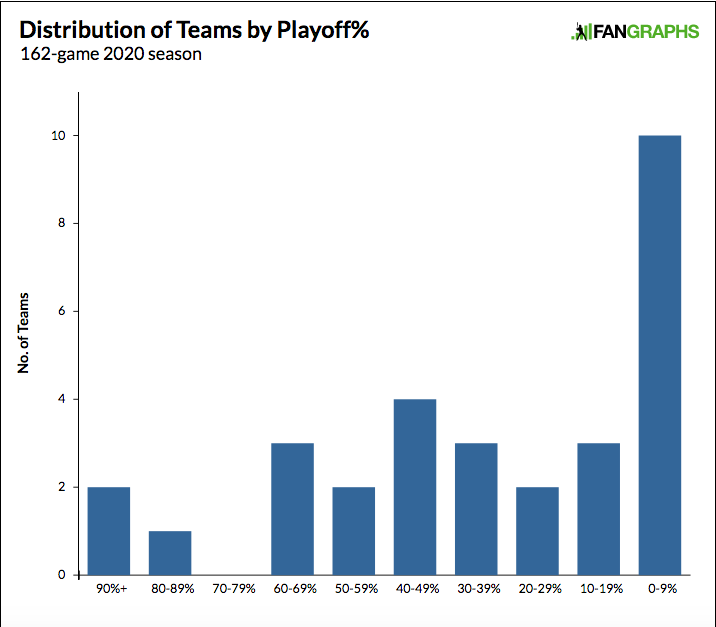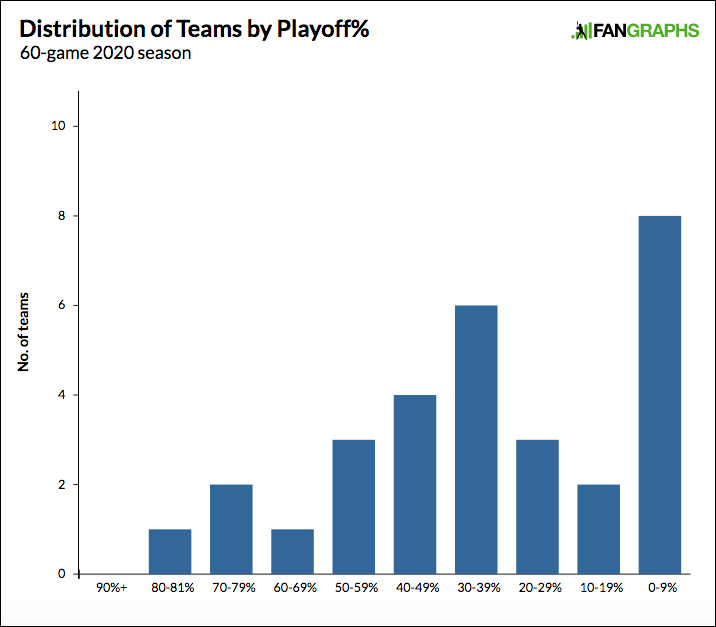Clearly, it’s been a long time since any of us cared to discuss major league baseball transactions. The most recent post tagged with the “free agent signing” category on this site was a post by Craig Edwards writing up the Boston Red Sox signing of Colin McHugh all the way back on March 5; a pandemic is mentioned nowhere in the body of the text or in the comments section. It was a simpler time, and a lot has changed since then. The schedule is 102 games shorter now. The games themselves are going to look very different. And there isn’t even a guarantee that a full season will be completed.
It’s difficult to wrap your brain around roster moves under the weight of everything else that’s happening, and fortunately, we haven’t had to. Shortly after it suspended the season, Major League Baseball enacted a transaction freeze, prohibiting teams from trading or signing anyone to their roster. That freeze will be lifted Friday at noon, freeing front offices up to put the finishing touches on their rosters ahead of what’s going to be a very short, strange season. It’s a big step toward normal baseball activities resuming, but it’s also difficult to know how much organizations will actually try to accomplish. Even before the legitimacy of the season itself could be called into question, teams already showed some reticence to maximize their competitiveness and front offices have a lot to figure out about a very unique and potentially dangerous situation and not a lot of time.
Still, there has to be some incentive to win, right? Teams like the Dodgers, Reds, and White Sox have already committed a lot of resources to the 2020 season. Then there are the teams that didn’t expect to be competitive this year but, because of a dramatically shortened season, suddenly see only about five or six games separating them from the playoffs instead of 15-20. The banners teams hang for winning this year will be just as big and colorful as they are for any other season, and for the clubs that have decided to go for it, every little bit is going to help. And though the offseason was very nearly over by the time play was initially suspended, there were still a few players on the market waiting to potentially make a difference for someone. Here’s a refresher on some of the better names available:
Yasiel Puig
Yasiel Puig is the best available free agent left, someone we’ve already covered at length several times here at FanGraphs. There’s no need to go in depth again, but to recap very quickly: Puig is still just 29, and is coming off a year during which he was traded twice in eight months. The 2019 season was his worst in three years from both a WAR and wRC+ perspective, but even then he remained average with his bat. The 1.8 WAR ZiPS projected him for (in the case of a 162-game season) is higher than the total right field projection of 17 teams. Whether it’s a true contender like St. Louis or a rebuilding team that could benefit from some extra jersey sales like Detroit, there are plenty of fits for Puig to play baseball in 2020.
Russell Martin
At 37, Russell Martin doesn’t pose the same threat in the batter’s box he once did, but that isn’t to say he’s done being a valuable player. His glove — boosted by framing metrics that placed him in the 95th percentile of all catchers last year according to Baseball Savant — was still good enough that he was worth 1.2 WAR for the Dodgers despite playing in just 83 games (he did respectably by our metrics as well). His days of 15-20 home run power are over, but he’s walked in at least 12% of his plate appearances every year for four seasons now, a rate that makes him a credible on-base threat regardless of his batting average. Teams carrying active rosters of 30 players to start the year makes it very likely most, if not all, will hold onto three catchers, and Martin would make a lot of sense for a team like the Mets or Cubs that lack a really impressive glove behind the dish.
Aaron Sanchez
A rethinking of Aaron Sanchez’s arsenal to emphasize his hard four-seamer and high-spin curveball did nothing to reverse what is now a three-year tailspin after his breakout in 2016. That season, he held opponents to a 3.00 ERA and 3.55 FIP in 30 games to amass 3.5 WAR, but since then, he’s been hit with a 5.29 ERA and 5.12 FIP in his last 55 games. He’s a former 34th overall pick who has flashed success in the majors and July 1 will be just his 28th birthday, so it seems more likely than not that a team will step forward and try to fix him — a club like the Reds, a team with a new pitching regime, makes sense here. But if a team were going to buy into him as a project, one would think they would have done so before spring training, and before the number of games they had to work with in 2020 (not to mention minor league opportunities) got severely cut down. (Update: I failed to note that Sanchez underwent shoulder surgery in September and was likely to miss most of this season.) There’s a good chance he gets passed over until 2021.
Andrew Cashner
For the first half of 2019, Andrew Cashner was the lone bright spot of a woeful Baltimore Orioles rotation. Then he got traded to Boston, where he was moved to the bullpen and got rocked. During his time with the Orioles, he held a 3.83 ERA and 4.26 FIP by basically doing Andrew Cashner things — he struck out just over six batters per nine innings, but walked fewer than three per nine, and limited homers well by generating lots of groundballs. Cashner has played for six different organizations over the past 10 years now, and he’s rarely been bad. Over the past seven years, he’s failed to throw 150 innings just twice, and owns a 4.08 ERA and 4.24 FIP. He’s 33, but if you’re looking for a durable, inning-eating starter you could plug and play in the back half of nearly any rotation, Cashner is a good bet. Jason Vargas (4.51 ERA, 4.76 FIP, 1.8 WAR in 149.2 innings in 2019) is also available and has similar characteristics, though at 37 he’s considerably riskier.
Scooter Gennett
Also previously covered in depth on this site, Scooter Gennett was dreadful coming off a groin injury in 2019, playing 42 games and finishing with -0.5 WAR a 44 wRC+, a 1.4% walk rate, and a 29.5% strikeout rate, and he lacks the defensive capabilities that can give some other infielders a high floor. Before the groin injury, though, he’d been worth 6.7 WAR over his previous two seasons with a 124 wRC+. Assuming he’s healthy now, he’d make a fine left-handed bench bat for a lot of teams.
The Relievers
Fernando Rodney is 43 now, but his fastball velocity is still in surprisingly decent shape, declining by less than a tick and a half over the last four seasons and clocking in at 94.4 mph on average. His World Series line (2 IP, 2 R, 2 H, 6 BB, 0 K) left something to be desired, but overall, his time in the regular season with the Nationals (33.1 IP, 4.05 ERA, 3.71 FIP) went over pretty well. Baseball’s more fun with Rodney in it, so let’s hope someone takes a flyer.
Sam Tuivailala is a weird story. The good news: Three straight seasons of sub-3.50 ERAs between St. Louis and Seattle, more than 10.5 strikeouts per nine last year, and he’s still just 27 years old. The bad news: Lots of time missed due to injuries, the most concerning of which is an Achilles injury the recovery from which hasn’t been seamless. Usually mid-to-upper-90s with his fastball, he reportedly had yet to throw harder than the upper 80s in camp this spring with the Mariners, who released him a week after the season was postponed. I’d imagine a few teams will be willing to work him out once they get the opportunity.
Arodys Vizcaino sat out nearly all of 2019 with shoulder inflammation, which is certainly concerning. Since 2017, however, he has just a 2.53 ERA in 99.2 innings while striking out nearly 10 batters per nine. He won’t turn 30 until November, so it might not be a bad idea to invest a little cash and a spot on your taxi squad in him.
Danny Salazar last threw meaningful big league innings in 2017, as a once-exciting career has been derailed by shoulder, elbow, and groin injuries. When he finally returned for four innings in 2019, his fastball was nearly 10 mph slower than it was the last time we’d seen him. He’d be a reclamation project for a rebuilding team like Baltimore with innings to give.
Blake Wood hasn’t pitched since being diagnosed with a right elbow impingement in April 2018, but carried favorable peripherals as a workhorse reliever in 2016-17. He’s 34, but there might be something left in the tank.



